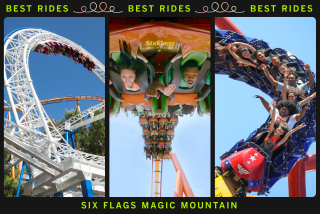Unlikely Tokyo Bay Site Is a Holiday Hit : Disneyland: For millions of Japanese, Mickey Mouse and Space Mountain are a vacationer’s dream.
- Share via
MAIHAMA, Japan — Mizue Daikoku and her family spent 16 hours driving from their home near Kyoto recently to line up at the gates of Tokyo Disneyland in the middle of the night. After a few hours of sleep in the car, they joined 100,000 compatriots for a day and evening of Dumbo rides, jungle cruises and flights through Never-Never Land. Then they drove home.
It might not sound like much of a summer vacation, but for the Daikoku family and millions like them, Disneyland and the marbled luxury hotels that surround it have become a runaway success.
But if this area is the heart of Japan’s much-touted leisure boom, it strikes many foreigners as a most unlikely site for a holiday. While the name Maihama--which means Dancing Beach and is intended to sound something like Miami--may conjure a seductive image of palm-fringed coasts, the reality is somewhat different.
Just minutes from downtown Tokyo, the resort area sits atop a recently reclaimed section of murky and very industrial Tokyo Bay, where a swim could be perilous and the view of nearby skyscrapers is often obscured by the city’s daily covering of haze, smoke and automobile emissions.
Railroad tracks run nearby, factories puff away, dredging machines churn in the harbor and Tokyo’s legendary traffic snarls along nearby elevated highways.
But in a country as crowded and developed as Japan, large swaths of buildable land are rare. In Maihama, developers and hoteliers have made the best of their opportunity, concealing the less appetizing surroundings behind artfully sculpted bushes and palm trees, and building airy hotel interiors and exotic swimming pools that give the impression of a swank and restful resort.
In addition, it turns out that being near Tokyo--with a greater metropolitan area of some 30 million people--provides some real advantages as well as the apparent drawbacks. Because many Japanese take summer holidays of only two or three days, proximity is a big plus for any resort.
More than half the visitors to Disneyland and its surrounding hotels come from Tokyo and its suburbs, looking for an escape from typically tiny houses, nonexistent back yards, noise and congestion.
Thus, despite skepticism 15 years ago when developers began planning Disneyland for a 200-acre site then mostly submerged beneath Tokyo Bay, today it is flourishing.
Since the theme park opened in 1983, it has attracted about 70 million visitors, more than half the population of Japan. Only 5.5% come from overseas, mostly from surrounding Asian countries and the United States. On peak August days, almost no ride is accessible without a two-hour wait.
“Before Tokyo Disneyland, Japanese people didn’t have much opportunity as far as having money or spare time to spend,” said Yoshiro Fukushima, assistant publicity director for Disneyland. Now it is clear that “people seem to want to get away from their daily lives” and have more time and money to do it.
The hotels, which inspired at least as much skepticism as Disneyland itself, have fared equally well. The 742-room, marble-and-glass Tokyo Bay Hilton International, where rooms range from $155 per night for the cheapest double to $1,330 for a two-room suite, has been a hit since it opened 13 months ago. “Maybe there was one Saturday since we opened when we were not full,” said General Manager Volkmar Reubel said.
“If we had opened five years earlier or later, we wouldn’t have succeeded like this,” said Toshio Kagami, a managing director of Oriental Land Co., which developed Maihama and owns and operates Tokyo Disneyland. “Five years earlier, the concept of leisure time hadn’t matured among the people; five years later, we would have had many competitors.”
Even now, Disneyland is 10 times larger than most of its Japanese competitors and imitators, and it is the anchor that has made Maihama such a success. Disney stores in each hotel are thronged with people buying Mickey Mouse golf tees, Mickey Mouse mirrors and other paraphernalia; trains back to Tokyo are filled with normally staid Japanese husbands clutching Disney balloons and sporting Donald Duck T-shirts.
So many people flock here that the government converted a cargo train line into a passenger line and opened a new station--Maihama--outside Disney’s front gate.
The Tokyo version of Disneyland is aggressively American, essentially duplicating the popular U. S. parks. From Space Mountain to It’s a Small World, rides are the same, walkways seem lifted intact from Anaheim or Orlando, and many signs and announcements are in English. (Most Disney characters here speak fluent Japanese, however.)
Even the food is typically American, and no Japanese noodles or obento --Japanese-style box lunches--are permitted through the gates. However, the management finally broke down and opened one high-quality Japanese restaurant after finding that many elderly Japanese were visiting who had never tasted hamburgers and had no intention of starting now.
With the success of Maihama, Oriental Land Co., which not too long ago contented itself with developing a few shopping centers in Chiba prefecture, is contemplating building another theme park next to Disneyland, putting up more hotels and a separate shopping, drinking and night-life complex around the Maihama train station.
More to Read
Sign up for The Wild
We’ll help you find the best places to hike, bike and run, as well as the perfect silent spots for meditation and yoga.
You may occasionally receive promotional content from the Los Angeles Times.






